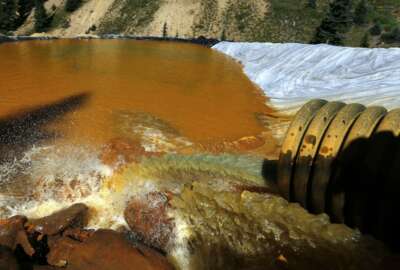Polyfluoralkyl chemicals known as PFAS are suspected of affecting people’s health, and the chemicals lasts nearly forever. One environmental group says two out of three Defense Department sites have excessive levels of PFAS in their groundwater. We get more now from policy analyst Jared Hayes of the Environmental Working Group. He talked to the Federal Drive with Tom Temin.
Jared Hayes: The Environmental Working Group, we’ve been tracking PFAS chemicals at Department of Defense bases for the past several years. And through Freedom of Information Act requests and public databases, we’ve been able to get testing data for PFAS chemicals on and around these bases. And so we’ve been able to go through that data and compare it to the newly released EPA lifetime health advisories for what is considered to be safe.
Tom Temin: Got it. And so give us some of the numbers. Where is the PFAS, how many places and what levels do we know that it’s at them?
Jared Hayes: Right now, the data shows that there are at least 266 installations with these toxic forever chemicals known as PFAS in the groundwater that are above the lifetime health advisories. And like I said, these are levels that EPA considers to be safe. And for two of the most well known and well studied PFAS, known as PFOA and PFOS, these updated levels are less than 1 part per trillion. And that’s compared to the old levels of 70 parts per trillion. And this essentially means that any detectable drinking water exposure is unsafe for human health.
Tom Temin: The safe level or allowable level, it’s not 1 part per trillion. It’s point 0.001 parts per trillion?
Jared Hayes: Yes, it’s below 1 part per trillion. That’s for PFOA, it’s point 0.004 parts per trillion. And for PFOS it’s point 0.02 parts per trillion. Essentially, that means that any detectable level is unsafe.
Tom Temin: And the levels are higher than that tiny fractional amount in the DoD facilities?
Jared Hayes: That’s correct. There are currently dozens of facilities that have over 100,000 parts per trillion. And there are several that have over 1 million parts per trillion around the U.S. and these are near major population centers. These are very large bases. And when PFAS enters into the groundwater, it doesn’t end at the baseline. It moves very quickly and can contaminate surrounding communities and surrounding well water. So it’s a major concern for DoD neighbors who are on their own well water and don’t know that they are contaminated.
Tom Temin: And this is primarily in the United States, or did this study also look at bases outside of the U.S.?
Jared Hayes: These are all within the United States.
Tom Temin: Where do we know so far that the PFAS even originates in the first place?
Jared Hayes: So for DoD bases, the primary source of PFAS has been coming from the firefighting foams known as AFFF. The Department of Defense has been using these since the 1960s. They helped develop them originally. And since the 1970s they have known that they are toxic. But it wasn’t until 2011, that the department began alerting service members of the toxicity. And then it wasn’t again until 2016 that they began taking serious action. And so they’ve been using these again for decades. But the Congress during the 2020 NDAA mandated that they phase out beginning for the Department of Defense and that’s to be completed by 2024. But that is still ongoing.
Tom Temin: We’re speaking with Jared Hayes. He’s a policy analyst at the Environmental Working Group. And I imagine most of the foam used was for practice firefighting because there can’t have been that many fires that required this in that period of time.
Jared Hayes: Yes, that’s correct. Most of it has been used for practice of emergencies, but it has also been used for emergency scenarios primarily for jet fuel fires, airplane crashes and the like. Right now they are not allowed to use firefighting foams containing PFAS chemicals in training exercises due to the health and safety effects. But they can still be used for emergency situations.
Tom Temin: And PFASes are known as chemicals that never degrade they last forever?
Jared Hayes: Exactly. They are known as forever chemicals, they do not break down. They are bioaccumulative and biopersistent. So that means once it’s in the groundwater, it can get into the plants and whatever is eating the plants it will get into them and so on so forth. And so it will get everywhere.
Tom Temin: And the EPA health advisories are kind of vague about whether there’s a definitive health danger, or just something that needs to be studied more at this point. What’s your sense of what the danger actually is, of these chemicals?
Jared Hayes: PFAS have been found to be toxic at very low levels and have been linked to serious health harms including increased risk of cancer, harm to reproductive and immune systems, and they’re found in so many everyday products and industrial applications. But the science has been clear. And it’s becoming more clear as we find out more about this entire family of toxic chemicals. The EPA has had scientists fairly clear when it comes to their advisory level, and they are working on a enforceable level. But right now, they have said that these advisory levels are what is considered to be safe.
Tom Temin: All right, and if there are detectable levels in groundwater, if you do nothing, that is to say, not add any more PFAS ever again, does the groundwater level eventually go down because groundwater moves, and it’s replaced with new groundwater?
Jared Hayes: Slowly it will go down, as we continue to use less and less of these PFAS chemicals. But it is persistent. There have been places where these chemicals haven’t been used for many years, and they’re still finding very high levels of PFAS contamination.
Tom Temin: So what should DoD do then, in your opinion, given the fact that the PFAS is in the water? And there are people using this water, drinking this water? Whatever else people do with water to consume it. What can they do about it, given the fact that it’s there now and it’s not going to go away?
Jared Hayes: Yeah, DoD needs to speed up the process with which they are using to clean up these chemicals. Right now they’re going through the Superfund or CERCLA [Comprehensive Environmental Response Compensation and Liability Act] process at many of their sites, but no real cleanup has begun. And they haven’t entered the cleanup phase of CERCLA at majority of these sites. And so you have communities around those bases that are still being exposed to the vast chemicals and aren’t seeing an end right now.
Tom Temin: And you said some places have millions of parts per trillion. What’s the worst place?
Jared Hayes: The worst place that we have seen so far has been England Air Force Base in Louisiana, over 1.5 million for PFBS which there is a health advisory for currently, and over 7.1 million parts per trillion for PFOS and 3.8 million for PFOA, many orders of magnitude above the health advisory level.
Tom Temin: All right, then, are there techniques that can sequester it or dissolve it or make it go away? How do you get rid of it? How do you treat water that has it?
Jared Hayes: There are many technologies that are out there and available right now both for filtering, drinking water as well as groundwater. One of the methods been used for treating groundwater at these sites has been pump and treat, where they pump the groundwater out, use a treatment technology. Oftentimes it’s granulated activated carbon (GAC), and then pump the water, clean water back into the ground.





